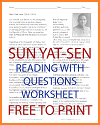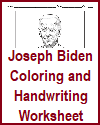| Donald Trump Reading Worksheet |
| www.studenthandouts.com ↣ Social Studies ↣ American Presidents ↣ Donald Trump |
|---|
| This two-sided worksheet features a reading on the presidency of Donald J. Trump (2017-2021), followed by questions. Click here to print. The answer key is below. |
 |
 |
|---|
|
The presidency of Donald Trump (born 1946), which lasted from January 20, 2017, to January 20, 2021, was marked by a number of notable policy initiatives, controversies, and events. It generated strong opinions and polarized the American public. Here are some key aspects of Donald Trump's presidency: Economic Policies: One of the major accomplishments often cited during Trump's presidency was a strong pre-pandemic economy. His administration enacted significant tax cuts in 2017, which reduced corporate and individual tax rates. Proponents argued that these cuts stimulated economic growth, while critics contended that they primarily benefited the wealthy. Deregulation: The Trump administration pursued an aggressive agenda of deregulation across various industries, aiming to reduce what they saw as burdensome regulations on businesses. This included rollbacks of environmental regulations, financial industry regulations, and consumer protections. Immigration: Trump's stance on immigration was a defining feature of his presidency. He implemented policies such as the travel ban on several predominantly Muslim countries, family separation at the U.S.-Mexico border, and attempts to end the Deferred Action for Childhood Arrivals (DACA) program. These policies generated widespread criticism and legal challenges. Foreign Policy: Trump pursued an "America First" approach to foreign policy. He renegotiated trade agreements like the United States-Mexico-Canada Agreement (USMCA), imposed tariffs on various countries (particularly China), and withdrew the United States from international agreements such as the Paris Agreement on climate change and the Iran nuclear deal. His administration also brokered normalization agreements between Israel and several Arab nations. Healthcare: Efforts to repeal and replace the Affordable Care Act (Obamacare) were a prominent feature of Trump's early presidency, but these efforts ultimately failed. The Trump administration did, however, make changes to certain aspects of the healthcare law through executive actions. COVID-19 Pandemic: The Trump administration faced significant criticism for its response to the COVID-19 pandemic. Some praised the Operation Warp Speed initiative, which accelerated the development of vaccines, while others criticized the administration's handling of testing, messaging, and public health measures. Impeachment: Trump was impeached twice by the House of Representatives. The first impeachment, in December 2019, alleged abuse of power and obstruction of Congress related to his dealings with Ukraine. The Senate acquitted him in February 2020. The second impeachment, in January 2021, charged him with incitement of insurrection following the storming of the U.S. Capitol by some of his supporters. The Senate trial occurred after his term ended, and he was acquitted once again. Social and Racial Issues: Trump's presidency was marked by significant social and racial tensions, particularly in the wake of protests over racial injustice and police violence. His responses to events like the white supremacist rally in Charlottesville, where a woman protesting the rally was purposely hit and killed by a motorist, and the Black Lives Matter (BLM) protests, generated controversy. Judicial Appointments: Trump appointed three Supreme Court justices during his tenure (Neil M. Gorsuch, Brett Kavanaugh, and Amy Coney Barrett), shifting the Court's balance to a more conservative majority. He also appointed numerous federal judges at lower levels, leaving a lasting impact on the judiciary. Donald Trump's presidency was highly polarizing, with strong support from his base and strong opposition from many quarters. Public opinion on his policies and leadership style remains deeply divided, and the legacy of his presidency continues to be a subject of debate and analysis. |
|
ANSWER KEY 1. What sectors were deregulated under Trump? environmental regulations, financial industry regulations, and consumer protections 2. What does the acronym DACA stand for? Deferred Action for Childhood Arrivals 3. Name a country against which Trump applied tariffs. China 4. Obamacare is more formally known as what? Affordable Care Act 5. What was Operation Warp Speed? accelerated the development of vaccines during the COVID-19 pandemic 6. How many times was Trump impeached? 2 7. What happened in Charlottesville during Trump’s presidency? white supremacist rally, where a woman protesting the rally was purposely hit and killed by a motorist 8. Who was appointed to the United States Supreme Court by President Trump? Neil M. Gorsuch, Brett Kavanaugh, and Amy Coney Barrett 9. Describe the divisiveness which deepened in the United States under President Trump. Answers will vary. |
| www.studenthandouts.com ↣ Social Studies ↣ American Presidents ↣ Donald Trump |
|---|











